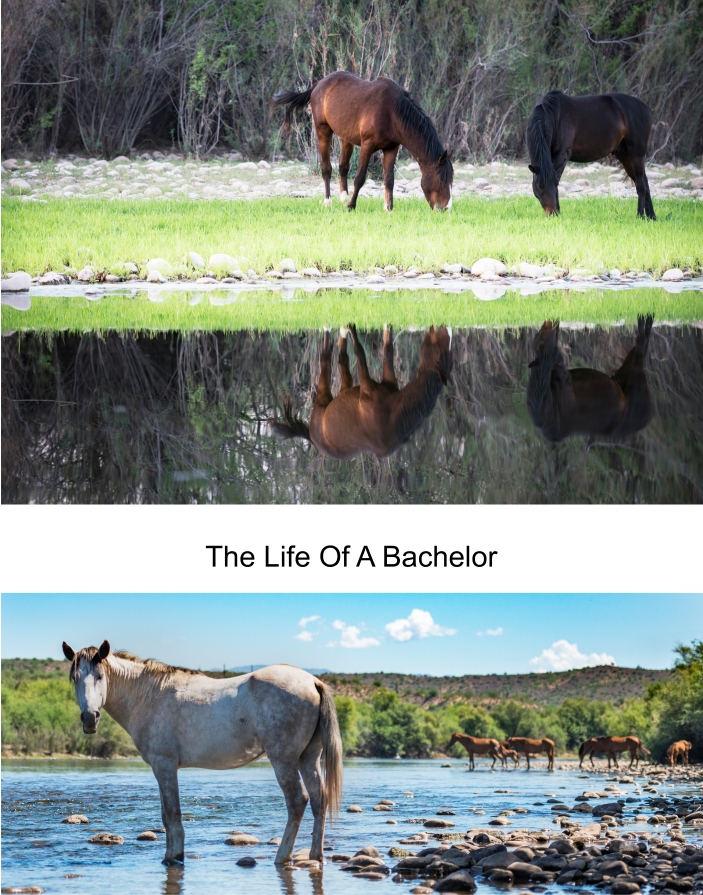The Bachelor

Patrick
Who can resist a bachelor? Well…within the world of the wild horses, actually quite a few. Lead stallions are amongst their most fierce adversaries. But never discount the feisty disposition of a band mare. If targeted by a bachelor, a mare may protest such unwanted advances with a hind end kick that can result in severe damage to ego and body, alike.
To understand the bachelor (yes that does apply to more than just the human species), a bit of information regarding the stages of development will aid in the learning curve.
The first month after birth can prove the most dangerous if not fatal. The primiparous female (first time mother) lacking the experience of the multiparous, will suffer a higher infant mortality rate. Accidents/injuries can lead to separation from mother, and thus death by starvation or predation. Within the Tonto National Forest mountain lions are known predators. Drowning is also a factor for the Salt River Wild Horses as they must cross the river often in order to graze. The river runs high in summer months, often with strong undercurrents. The very young lack muscle strength required to maneuver through such physical barriers, and thus depend on the wisdom and innate behavior of the mother for their safe passage. It is not uncommon to view a mother cross the river with the young foal carefully positioned next to the mare, so as to prevent getting caught in the current. This maternal behavior is believed to be innate.

A mother leads a very young foal across the river, maneuvering with the memory of the river’s bottom much like we maneuver a well traveled highway. The foal, only days old, must trust the maternal protective instinct to guide him through waters that could prove fatal. As the foal has strong maternal bonds, he will remain close to the mother even when prompted to travel across dangerous and challenging terrain.

A mare carefully crosses the river, maintaining body contact with her foal, preventing him from being caught by the current and washed away.
As is the way of wildlife, challenges for survival are most fatal for the young. But as time progresses, muscles develop as does the brain and thus experiences become more complex if not just fun.
As the young male grows, it is not uncommon to come across two or three adjacent bands grazing in the same area. Young males from these different bands can be viewed play fighting. These bouts can be really rowdy…..I mean really rowdy. Observing two 800 pound wild horses, running, jumping, kicking, biting, pouncing (hearing the occasional thump that radiates throughout the forest of a body hitting the ground) can be somewhat unnerving for even the most seasoned observer. Coined dominance fighting, (I know not much imagination went into that nomenclature) this behaviour functions to train both males for the physical matches and stamina that will be necessary to obtain their own female, and subsequently establish his own band.

Image 1: Young male from adjacent band spots bachelors
Image 2: Horses smell each other (Meet and Greet)
Image 3: Young male incites action to begin play fighting
Image 4: Play fitting taken to the next level
Image 5: Play fighting taken to a level best categorized as intense: good training for both young male and bachelor
Between the ages of 2-3 years the young male will venture out or be expelled from his original band. The newly independent male will either remain solo, or seek the company of others. Any human male can empathize with this time of life. Some days are definitely better than others…..

Bachelors are most likely to begin seeking to create their own band between years 4-5. Although younger is not unheard of, it is rare simply due to anatomical physical strength limitations. The bachelor will need not only the physical fortitude to acquire a female(s) from an established band (meaning the inevitable dominance fight between himself and the lead stallion), but the grit and determination to overpower the lead stallion, subsequently removing a mare(s) from her established band. Remember the previous discussion of the mare’s hell and brimstone temperament? Such behavior can go on for days, depending on physical fitness of both males and the determination of the female to remain with the original band or succumb to the bachelor’s efforts to claim possession. As there are more bachelors than head stallions, the newly crowned head stallion often returns to the position of bachelor. Such is Mother Nature’s way of ensuring only the most desirable genes will be passed from one generation to the next. Yes, humbling to the bachelor who desires a more prestigious status within the herd. But as we all know, never underestimate the tenacity, cunning, brashness, and/or fortitude of a bachelor…….
